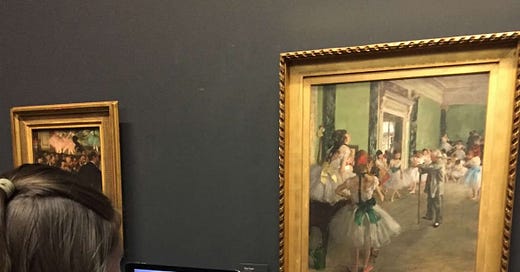The Underrated Power of Taking a Picture
Why Photographing Daily Life Experiences Boosts Well-being
One of my favorite photos is one I took of my daughter - then age 12 and an aspiring ballerina - while she is taking a photo of one of Degas’s famous ballerina paintings in the Musée d'Orsay in Paris.
I love this photo in part because she’s so intensely studying the painting - through the lens of her phone - and clearly connecting with the image. And I remember hoping that she’d remember this painting - and this trip - for the rest of her life.
We often focus on the downsides of taking photos, and how doing so interferes with our ability to really savor the moment. If you’ve ever seen people filming as they walk around a museum or attend a child’s musical performance, you know exactly what I mean.
But the scientific research on picture taking reveals a considerable upside. Researchers in one study led study participants on a guided tour of an art museum. Some people were asked to photograph particular objects, others were asked to simply observe these objects, and still others were asked to zoom in and photograph a particular part of the object.
When researchers tested people’s memory for the objects the next day, people who had taken a general photograph of the object remembered less than people who had observed the objects without taking a picture. But people in the third group - who had zoomed in closely on a particular part of the object for their picture - remembered just as much about the object as those who simply observed the object.
These findings clearly illustrate that when it comes to taking pictures, quality is more important than quantity. Taking a close up picture of a particular part of an object led people to focus intensely on the image, and thereby remember more details.
But taking particular types of pictures doesn’t just help us remember objects and events more accurately; taking pictures can also boost well-being.
Researchers in one clever study asked people to participate in some type of daily life activity, such as eating a meal in a food court or taking a bus tour of famous sights in Philadelphia. Half of the people were told they could not use their phones during the activity, whereas the other half were told they should take at least 10 pictures during the experience.
At the end of the activity, the researchers asked study participants to rate their overall enjoyment and engagement in the experience.
Now, you might predict that stopping to take pictures would distract from people’s ability to really immerse themselves in the activity, and thereby make the overall experience less enjoyable.
But their findings revealed the exact opposite: people who took pictures were more engaged in the activity, which in turn increased their overall enjoyment.
And it’s not just taking pictures of novel activities that feels so good.
Researchers in yet another study asked college students to take a particular type of photo every day for four weeks:
Students in one group were told to take a selfie while smiling
Students in another group were told to take a picture of something that made them happy
Students in the third group were told to take a picture of something that would make another person happy - and to then send the photo to that person.
Students in all three groups experienced increases in positive affect over the month, providing clear evidence that picture taking is an under-rated strategy for feeling better.
Here’s the simple takeaway from all of this research: photographing novel experiences and daily life activities is a great way to increase happiness. Just remember to stay engaged in the moment.
Now a couple of questions for you: How often do you take pictures - and what do you tend to photograph? And what’s your favorite photograph? Please share in the comments!





I like to work on old cars, and during the often drawn-out process, I like to take pictures of what I am doing. Later, I made a book, using Shutterfy, to document the project. Each picture in the small books takes me back to that part of the build, and I enjoy reliving the progress I made at that point in time.
Fascinating. This is news to me, but I know I have experienced happiness in proportion to picture taking. The sharing of pix is especially satisfying as a form of communication. Also, for gear heads at least, cameras and lens themselves - how they work, their quality, etc. - is a source of (mild) pleasure. Catherine, did your daughter go on to become a ballerina?